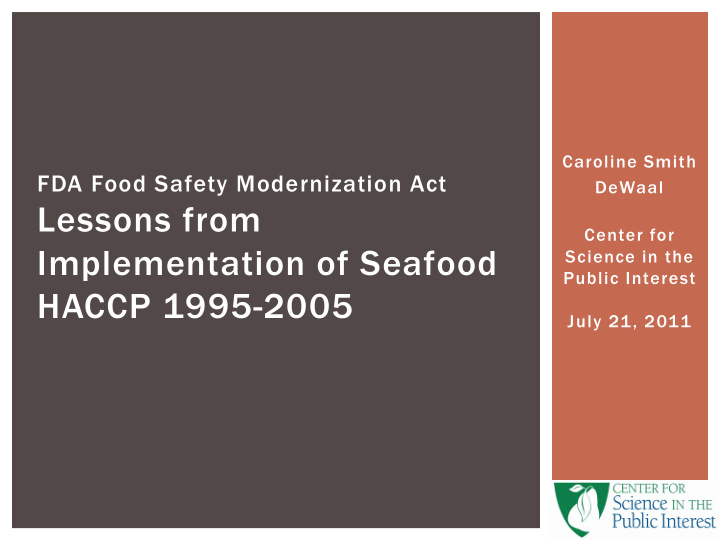



Caroline Smith FDA Food Safety Modernization Act DeWaal Lessons from Center for Implementation of Seafood Science in the Public Interest HACCP 1995-2005 July 21, 2011
CSPI/SFI and IACFO The Center for Science in the Public Interest (CSPI) is a bi-national NGO representing over 850,000 consumers in both the U.S. and Canada. Safe Food International (SFI), a CSPI project, partners with consumer organizations in other regions of the world on food safety issues. The International Association of Consumer Food Organizations provides representation in Codex for consumer organizations on five continents.
ELEMENTS OF EFFECTIVE FOOD SAFETY SYSTEMS Perform ance Preventative Standards Process Controls Registration Federal/ State Cooperation Im port SAFER Controls FOODS On-Farm Controls Inspections Enforcem ent Research and Education
SEAFOOD HACCP: IMPLEMENTATION & REVIEW Seafood HACCP Rule proposed March 3, 1994. Compliance phased-in over 2 years. Dec. 18, 1995 – Final rule published. Dec. 18, 1997 – All seafood firms required to have HACCP plans. Progress evaluations. 1998-99 – Only 44% of inspected firms have adequate plans.* 2000-01 – FDA ceased assessment of overall implementation. 2002-03 – Spike in firms without plans blamed on warehouse inspections. 2004-05 – Only 77% of histamine firms had adequate monitoring.† Completion of implementation? 2005 – Only 86% of inspected firms had plan when needed. * Does not include facilities that had no risk and, therefore, did not need plans. † Histamine (scombroid poisoning) is a temperature abuse/monitoring issue.
APPARENT PROGRESS? BASELINES AND TRACKING No baseline for measuring progress. 1992 study of 3 segments of industry. FoodNet does not track most common seafood hazards other than vibrio Verification testing made optional. Source: CSPI’s Outbreak Alert!.
TRACKING ONE COMMON SEAFOOD HAZARD FoodNet indicates HACCP has not controlled Vibrio. Source: CDC, MMWR 2011
MISSING OR INADEQUATE HACCP PLANS Adulteration Warning Letters 2000-2009 CSPI reviewed N=2210 warning letters from 500 2000-2009. 450 On average 50% of 400 warning letters are for 350 missing or inadequate 300 seafood HACCP plans. 250 10 years after first 200 evaluation, 43% of 150 warning letters 100 reference seafood 50 HACCP compliance 0 issues. 2000 2001 2002 2003 2004 2005 2006 2007 2008 2009 Seafood HACCP Letters Total Adulteration Letters Source: Compiled from FDA warning letters.
SEAFOOD PROCESSORS MORE LIKE TO REPEAT Compliance Rates. Rule was fully effective in 1997 Seafood HACCP More Likely to be Topic Over 80% compliance achieved of Repeat Warnings, 2000-2009 by 2001 (4 years) N=93 Moderate gains in compliance rates after that time (peaked in Other Violations 2005 at 86%). 33% FDA indicated in 2002 “regulatory action may be necessary to correct much of the remaining non-compliance.” Seafood HACCP 67% Repeat violations are evidence of weak follow-up. Source: Compiled from FDA warning letters, repeat warnings for all food categories.
LESSONS FROM SEAFOOD HACCP IMPLEMENTATION Prob oble lems: 10 years after rule published, full implementation (95%+ of industry) still not achieved. Without baseline & consistent/appropriate metrics, progress is hard to assess. No apparent follow-up to close gap on non-compliance. Soluti tions: s: Greater assistance and insistence on compliance. Identify baseline studies; develop tracking system that allows firms to recognize their progress. Evaluate performance and take actions against firms that fail to comply. Avoid silos and make links between authorities. Environmental testing (§ 418(f)(4)) – Specify as a requirement. Test reporting (§ 422(b)(2) & (d)) – Require labs to forward results of positive tests.
FSMA: IMPLEMENTATION OF PREVENTIVE CONTROLS President Obama signed FSMA into law on Jan. 4, 2011 Compliance phased-in over 3 years. July 4, 2012 – Facilities other than small and very small must have food safety plans and preventive controls in place. ~Jan. 4, 2013* – Small facilities must have food safety plan and preventive controls in place. ~Jan. 4, 2014 – Very small facilities must have food safety plan and preventive controls in place. * Deadlines for small and very small facilities dependent on date final regulations are issued.
THANK YOU! Caroline S oline Smit ith h DeWaa aal Center for Science in the Public Interest 1220 L St., N.W. Suite 300 Washington, D.C. 20005 Phone: (202) 332-9110 Fax: (202) 265-4954 E-mail: l: cdewaal@ l@cspin inet.org On t the i internet: www.cs cspinet.org and d www.safefoodin internatio ional. l.org
Recommend
More recommend